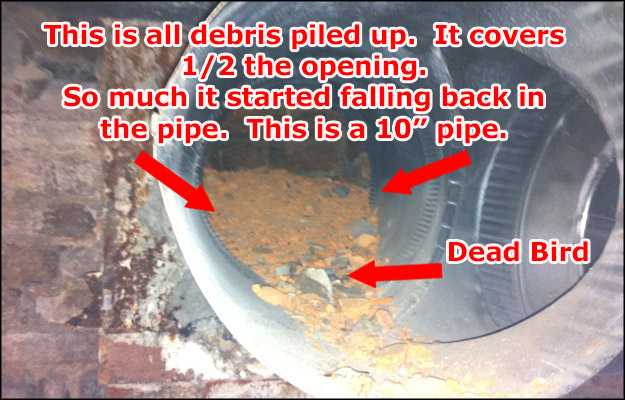Older Homes In York PA – Check Your Chimney Annually For Debris Build Up
As a safety precaution home owners and property owners should make it a habit to check their chimneys annually to ensure there is no blockage for the furnace and hot water heater to vent out of the chimney.
York PA Residents – This Applies To You!!
This is more applicable to older homes that have brick chimneys. Which is the case with most homes in York City.
Who Does This Exclude?
- If you have a chimney liner.
- Electric hot water heater.
- A high-efficiency furnace that vents through PVC out the side of your house.
Why Does This Happen?
With the older brick and mortar chimneys, the debris from the older brick and mortar deteriorates over time and falls to the bottom which is of course where your furnace and hot water heater are venting. Along with any dead birds, animals or other debris that has accumulated over time. If a build-up occurs and the air is not flowing correctly, asphyxiation and death could result for the people inside as well which is obviously a very serious problem.
This debris is loose and is like piling sand and dirt in the chimney, the vapors from the hot water heater and furnace can not escape. Thus backing up into the home or property. Note the picture below of how the loose brick broke away and fell to the bottom of the chimney. The pictures below came from one of our customers who did a chimney cleaning himself.
Checking Your Chimney Is Not That Hard To Do – With A Little Effort
As long as you are willing to get your hands a little dirty and invest a little time you can save a life and a service call.
To Get Started
Start in the basement, assuming your furnace and hot water heater are located there.
Check the air-flow at the air vent where the draft hood is by holding a match at the vent. You should see a strong draw up through the chimney, you should also be able to feel the draw of air on your hand.
If it’s a hazy smoke that is being drawn and not that strong you should pull the pipe stack off and check further.
Allow the smoke pipe to cool and then pull it out of the chimney. Often the smoke pipe will be set into the thimble (as in picture below) or chimney with mortar. If your smoke pipe easily comes apart, you can pull the joint out and leave the last six to ten inches there. Note in the picture below the pipes were disconnected to allow access to the chimney.

Okay The Pipes Are Apart Now What
Looking into the chimney you should be able to see daylight coming from above.
Inspect it with a flashlight and mirror while wearing a breathing apparatus to ensure there is not blockage.
Insert the mirror and angle up and you should see the opening at the end of the chimney and see daylight.
Using the flashlight look at the base of the chimney to see if any debris has accumulated. In the picture below, yes the customer could see daylight above, but as you can see there was quite a big pile of debris that had accumulated. The customer then used a shop vac to remove the debris.

A good practice is to do regular maintenance on the furnace, and when you do, also check the chimney.

Some furnaces will vent to the outside of the home through PVC so you will need to follow the PVC piping in order to identify where the exhaust exits. In that case you will not have this brick waste but still have to keep an eye out for any animals that entered the vent pipes.
Nonetheless, checking your furnace and regularly chimney cleaning can not only save you the cost of having someone else do it, but can also be life saving (quite literally). Most people should be able to do this themselves and dont realize that or how important it is.
Contact Wilbur Henry For Your HVAC needs In York PA
Wilbur Henry is the expert to call when you HVAC In York PA. When you need service we will treat you right.
Older Homes In York PA – Check Your Chimney Annually For Debris Build Up Read More »





